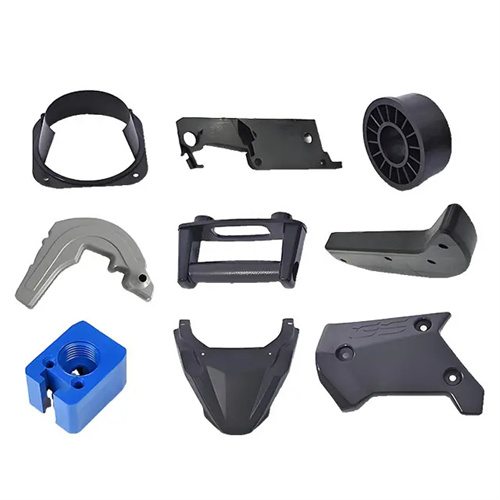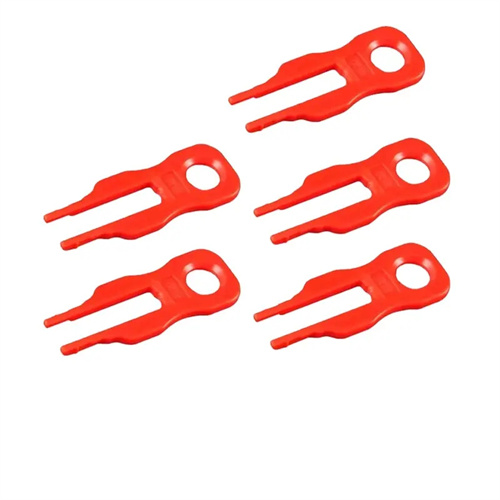Lateral core pulling mechanism for injection molding bent pins
The bent-pin lateral core-pulling mechanism for injection molding is a key device for demolding complex parts with lateral projections, holes, and other structures. It utilizes the inclined surface of the bent pin to drive a slider to perform the core-pulling operation. It boasts a compact structure, high core-pulling force, and reliable operation. It is widely used in the production of complex plastic parts such as automotive parts and appliance housings. Compared to traditional inclined guide pin core-pulling mechanisms, the bent-pin lateral core-pulling mechanism offers a greater core-pulling distance and a wider angle range (typically up to 30°-45°), meeting the requirements for core-pulling operations involving deeper lateral holes or more complex lateral shapes. For example, when producing a washing machine drum with a deep lateral hole, the bent-pin mechanism can achieve a core-pulling distance exceeding 100mm, ensuring smooth demolding of the deep hole, a feat hindered by traditional inclined guide pin mechanisms due to their limited core-pulling distance. Furthermore, the bent-pin mechanism offers greater rigidity and is less likely to deform during the core-pulling process, ensuring core-pulling accuracy and maintaining lateral dimensional tolerances within ±0.05mm.

The composition and working principle of the bent pin lateral core pulling mechanism are fundamental to understanding its function. The mechanism primarily consists of a bent pin, a slider, a guide groove, a locking block, and a positioning device. The bent pin is fixed to one side of the fixed mold and is typically rectangular or circular in cross-section, with the working portion inclined at a certain angle. The slider is mounted in the guide groove of the movable mold and connects to the lateral molding area of the plastic part. The locking block locks the slider during mold closing to prevent injection pressure from pushing it apart. The positioning device secures the slider in a set position after mold opening and core pulling to prevent interference with the bent pin during mold closing. The operating process is as follows: During mold opening, the fixed and movable molds separate, and the bent pin moves with the fixed mold. Its inclined surface drives the slider laterally within the guide groove, completing the core pulling operation. When the mold is opened to a certain distance, the slider disengages from the bent pin, and the positioning device secures the slider. During mold closing, the bent pin is reinserted into the slider’s guide hole, pushing the slider back into position. Finally, the locking block secures the slider, preparing for the next injection. For example, when producing a mobile phone charger housing with a lateral boss, the bending pin drives the slider to move outward during the mold opening process, separating the boss from the slider and achieving smooth demolding.

The design parameters of the bending pin directly impact the performance of the core-pulling mechanism and require precise calculation based on the requirements of the plastic part. The bending pin’s inclination angle is a key parameter. A too small angle will result in insufficient core-pulling distance, while a large angle will increase the bending force on the bending pin, potentially causing deformation or breakage. Generally, the inclination angle α should be between 15° and 30°, with a maximum of 35°. For applications with longer core-pulling distances, a two-stage bending pin can be used, with a smaller angle in the front section (15°-20°) and a larger angle in the back section (25°-30°). This ensures the core-pulling distance while reducing the stress on the bending pin. The length of the bending pin must be calculated based on the core-pulling distance and the inclination angle using the formula L = S / sin α + K, where L is the working length of the bending pin (mm), S is the core-pulling distance (mm), and K is a safety margin (typically 10-20mm). The cross-sectional dimensions of the bent pin must meet the strength requirements. The width and thickness of the rectangular cross-section should be determined according to the core pulling force. The general width is 10-30mm and the thickness is 8-20mm. The material used is Cr12MoV, and the hardness reaches HRC55-60 after heat treatment to ensure sufficient wear resistance and strength.

The design of the slider and guide runner is crucial for ensuring smooth core-pulling mechanism movement. The slider’s dimensions should be determined based on the size of the lateral molding area of the part. Its length is typically 1.5-2 times its width to prevent tilting during the core-pulling process. The slider should be securely and reliably connected to the lateral core, either by screws or a dovetail groove. The clearance between the core and slider should be 0.01-0.03mm to ensure molding accuracy. The guide runner and slider should utilize an H7/f7 clearance fit. The fitting length should be no less than two-thirds of the slider’s length, with a surface roughness of Ra ≤ 0.8μm to ensure smooth slider movement. To reduce wear, a wear-resistant plate made of bronze or hardened steel, 2-5mm thick, can be installed between the slider and guide runner and secured to the bottom of the guide runner with screws. The slider’s positioning device typically utilizes a spring pin or stop to precisely position the slider after core pulling, with a positioning accuracy of no more than 0.05mm. This prevents bent pins from colliding with the slider during mold closing.

The installation, commissioning, and troubleshooting of common problems with the bent pin side core pulling mechanism are crucial for ensuring stable production. During installation, ensure that the bent pin is aligned with the guide hole of the slider, with a coaxial error of no more than 0.1mm. Failure to do so can cause jamming during core pulling or pin breakage. The bevel angle of the locking block should be 2°-3° greater than the bend pin’s inclination to ensure secure locking and avoid interference during mold closing. During commissioning, gradually adjust the mold opening speed and core pulling stroke to ensure smooth slider movement and thorough core pulling. If the slider becomes stuck, check the parallelism of the guide runner and the perpendicularity of the bent pin, and regrind as necessary. Common problems and solutions: Insufficient core pulling force can cause part deformation. Increase the bend pin’s inclination angle or increase the cross-sectional dimensions of the bent pin. Unstable slider movement requires cleaning impurities from the guide runner and adding grease. If the locking block is worn, causing the slider to loosen, replace the locking block and adjust the clearance. Through careful design and commissioning, the bent pin side core pulling mechanism can achieve a service life of over one million mold cycles, meeting the needs of high-volume production.
